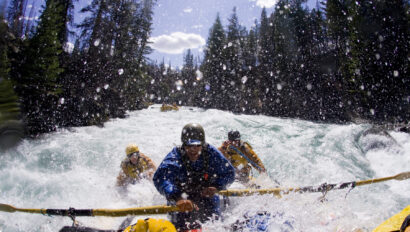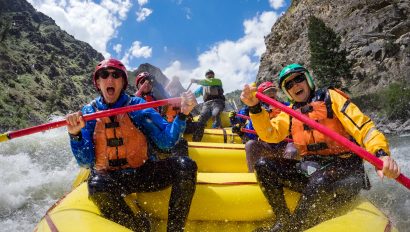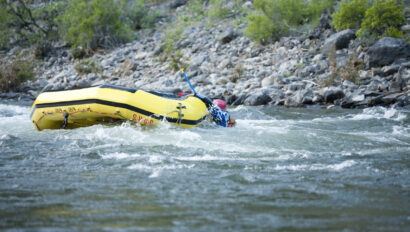2024 Western Rafting Outlook: “Goldilocks Conditions”
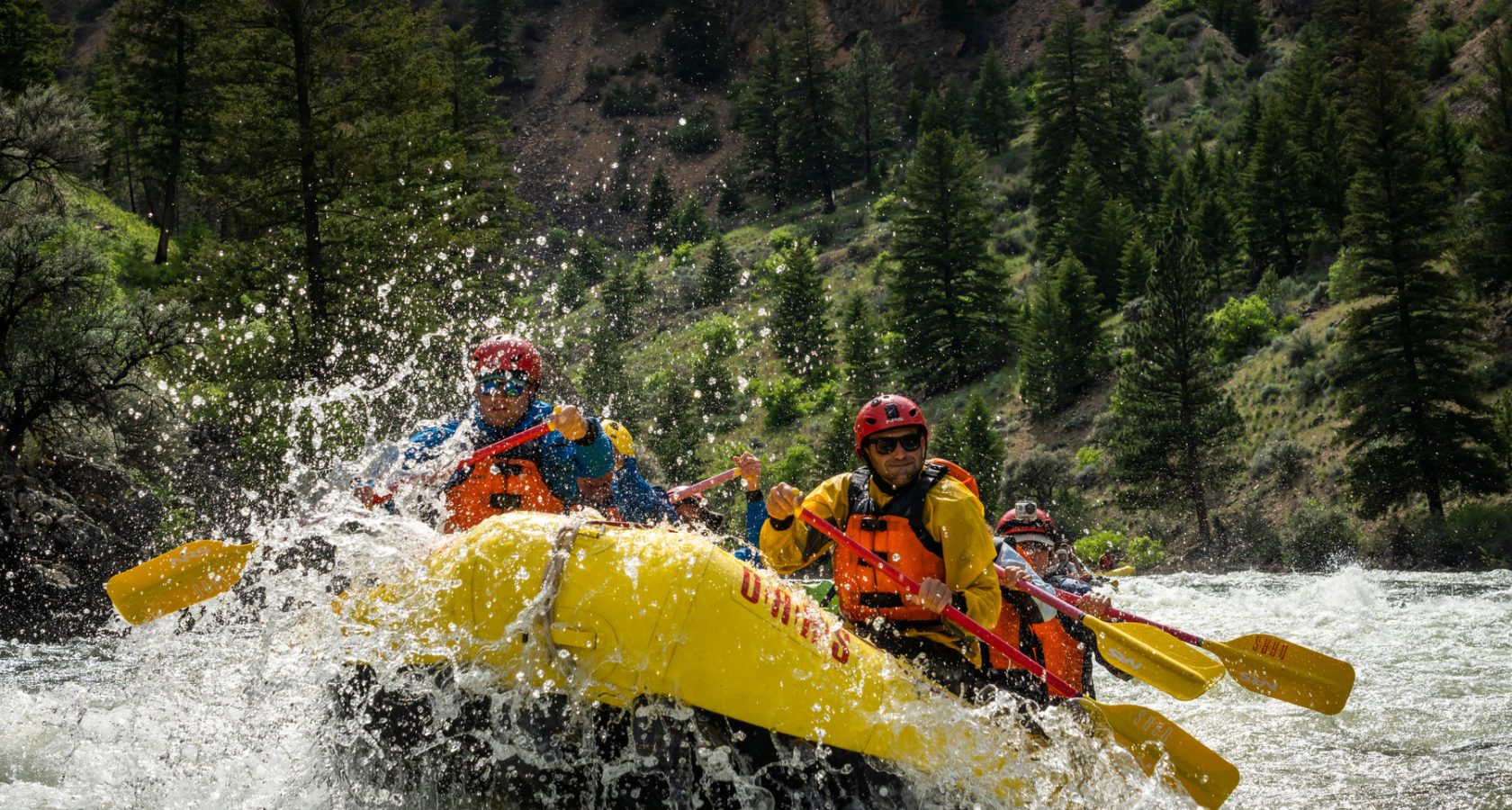

Where to Find the Best Whitewater in the West
The 2024 rafting season has commenced, and current snowpack totals in the western U.S. are a welcome balance for rafting outfitters following the historic high-water season of 2023.
SNOTEL data collected by the National Resources Conservation Service as of April 8 shows 2023-2024 winter snowpack totals (snow water equivalent) across many basins are at, or slightly above, the norm, with the exception of the Northwest and northern Rockies.
“Generally, snowpacks across the areas where we operate are averaging out,” says Seth Davis, OARS Director of Operations. “Not too high, not too low, but just right—’Goldilocks conditions’ for 2024.”
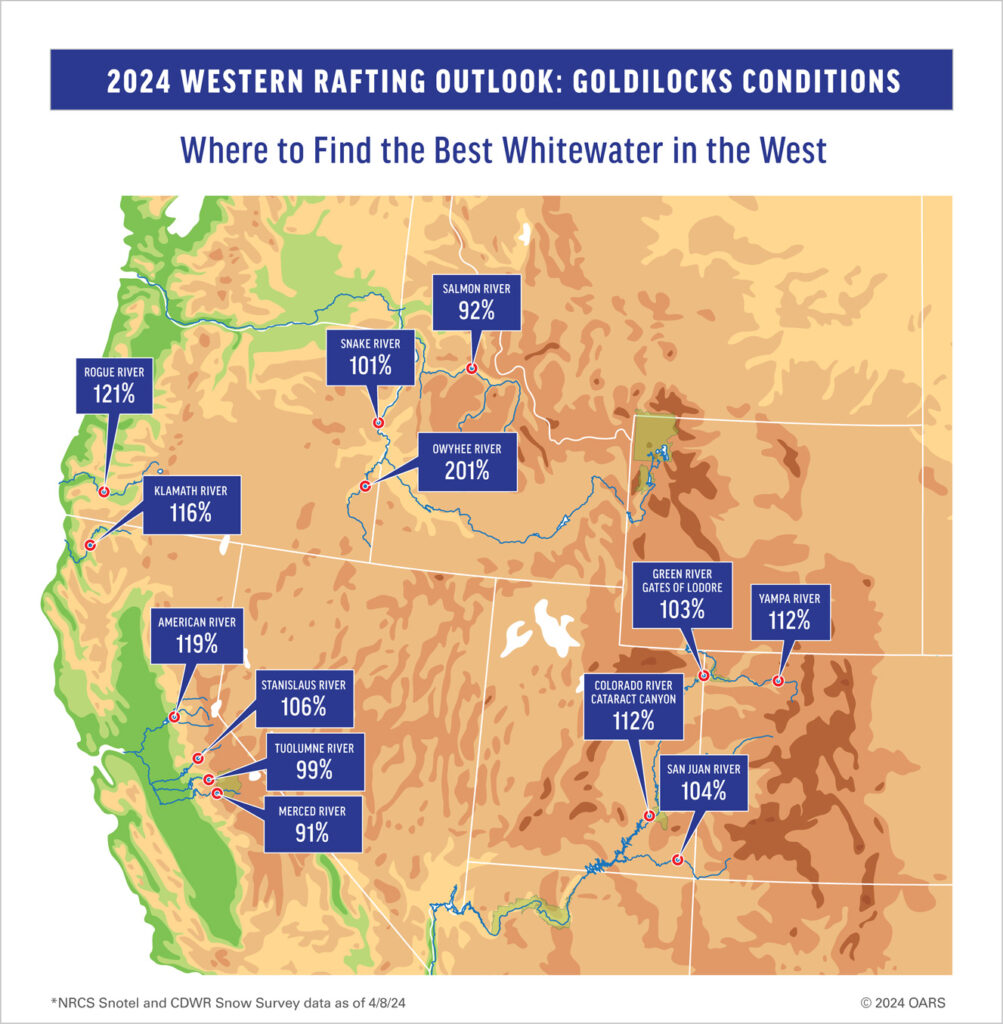
“For those in search of thrilling high-water trips, there’s good news,” continues Davis. “While this year might not be marked by consistently high water, there will be periods when certain trips encounter higher flows. It’s all about timing and choosing the right dates to book those trips.”
Meanwhile, those looking for a more “normal” river trip experience without the intensity of high water, will find the 2024 season much more accommodating, according to Davis.
The weather pattern in the upcoming weeks will ultimately dictate when, and for how long, outfitters will see peak flows on the rivers of the West, but in general, rafters can expect great flows well into summer and lower flows likely to not show up until later in the season.
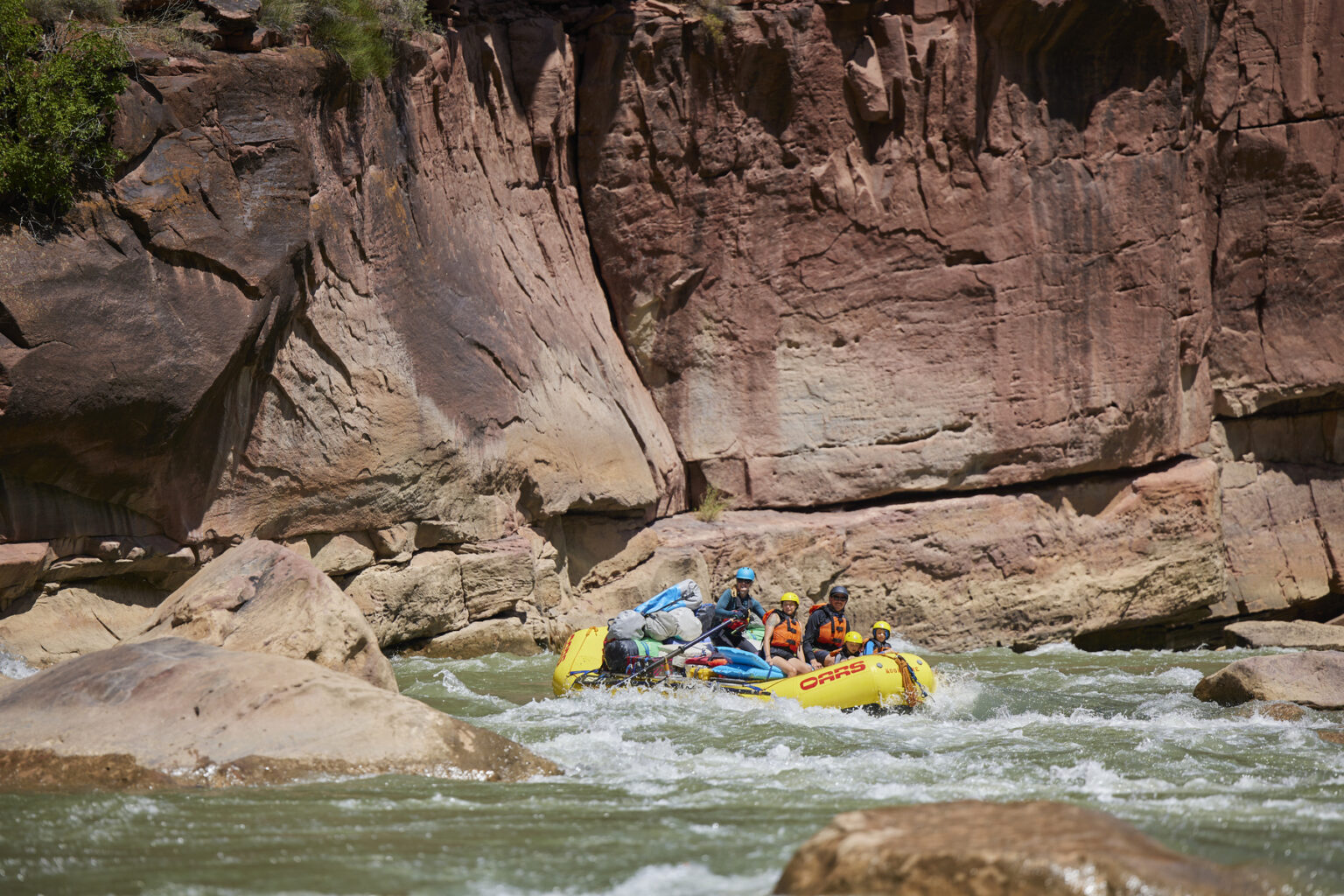
What to Expect During the 2024 Rafting Season
- Many of the West’s most popular whitewater rivers, like Oregon’s Rogue River, Utah’s Green River through the Gates of Lodore and Desolation Canyon, as well as Idaho’s Snake River will have optimal rafting conditions this season thanks to robust snowpack numbers across the majority of the West for the second year in a row, with the exception of the Northwest and northern Rockies.
- Those looking to experience the excitement of a high-water trip should set their sites on an early season trip between mid-May to early-June during peak snowmelt on free-flowing rivers like the Yampa on the Colorado-Utah border and Utah’s Colorado River through Cataract Canyon, which is forecasted to peak at an exciting 45,000 cubic feet per second (CFS).
- In California, it’s been a story of too much water or not enough in recent years, but this year’s near average to slightly above average snowpack numbers and healthy reservoir levels across the board means outfitters will have a consistent and long season on California’s dam-controlled rivers like the South Fork and Middle Fork of the American River, as well as the Tuolumne River near Yosemite. Meanwhile, the free-flowing North Fork of the American is expected to have raftable flows into early June, while the Merced River should be a good option for rafters into late June or early July, depending on how quickly the snow melts.
- A near normal snowpack in the Salmon River Basin means business as usual for the popular Lower, Main and Middle Fork of the Salmon River with elevated flows on early season trips, then tapering for the rest of the season, providing reliable flows into September.
- For the second year in a row, the Owyhee River on the Idaho-Oregon border is enjoying a snowpack that’s over 200% of normal, which means outfitters are well-poised to run this beloved spring trip that relies on “just right” water levels and weather patterns each season. Catch it if you can.
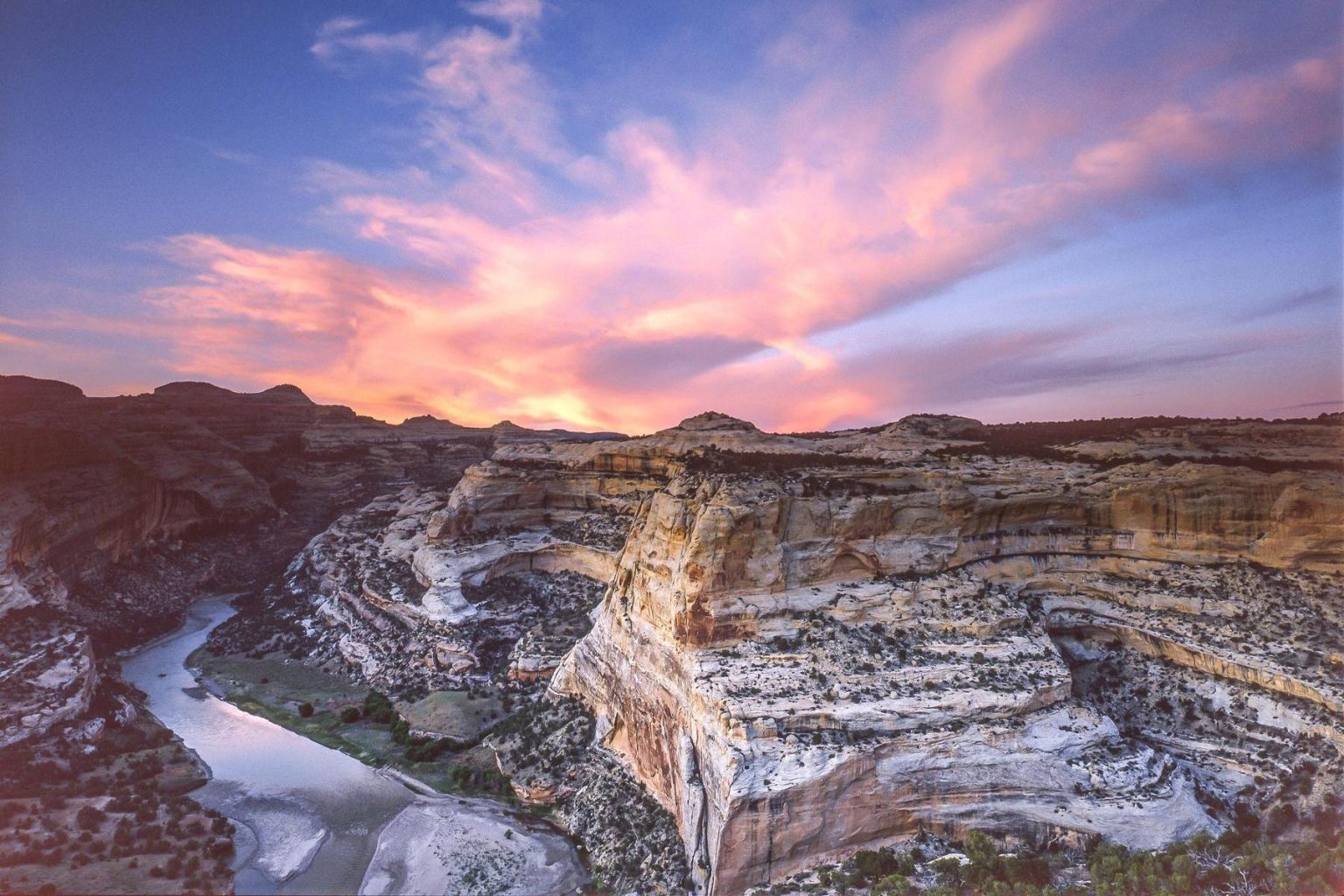
Colorado Rafting Outlook Solid
As of early April, the statewide snowpack in Colorado is at 109% of average, and SNOTEL data from the National Resource Conservation Service (NRCS) shows most of the major river basins range between 101% and 114% of the 30-year median.
With normal to slightly above normal conditions across the state, rafters can anticipate fun, raftable flows on all the state’s popular whitewater rivers like the Animas, Cache La Poudre, and the Arkansas, which has the best snowpack in the state at 117% of normal the second week of April.
The Yampa River Basin, at 112% of the April 1 average, isn’t far behind, with snowstorms still impacting the region.
“Every season we’re left guessing what Mother Nature plans to do,” says Nicole Lavoie, OARS Dinosaur Operations Manager. “We are still in a waiting pattern to see what happens in the next six weeks, but it’s looking like the Yampa could peak late May to the first week of June. We’re hoping for 10,000 CFS which can be a tricky, exciting level.”
Colorado’s Upper Colorado River Basin, Upper Green River Basin and San Juan Basins, also play a critical role for many of Utah’s best whitewater runs, which all have healthy snowpacks heading into the 2024 season.
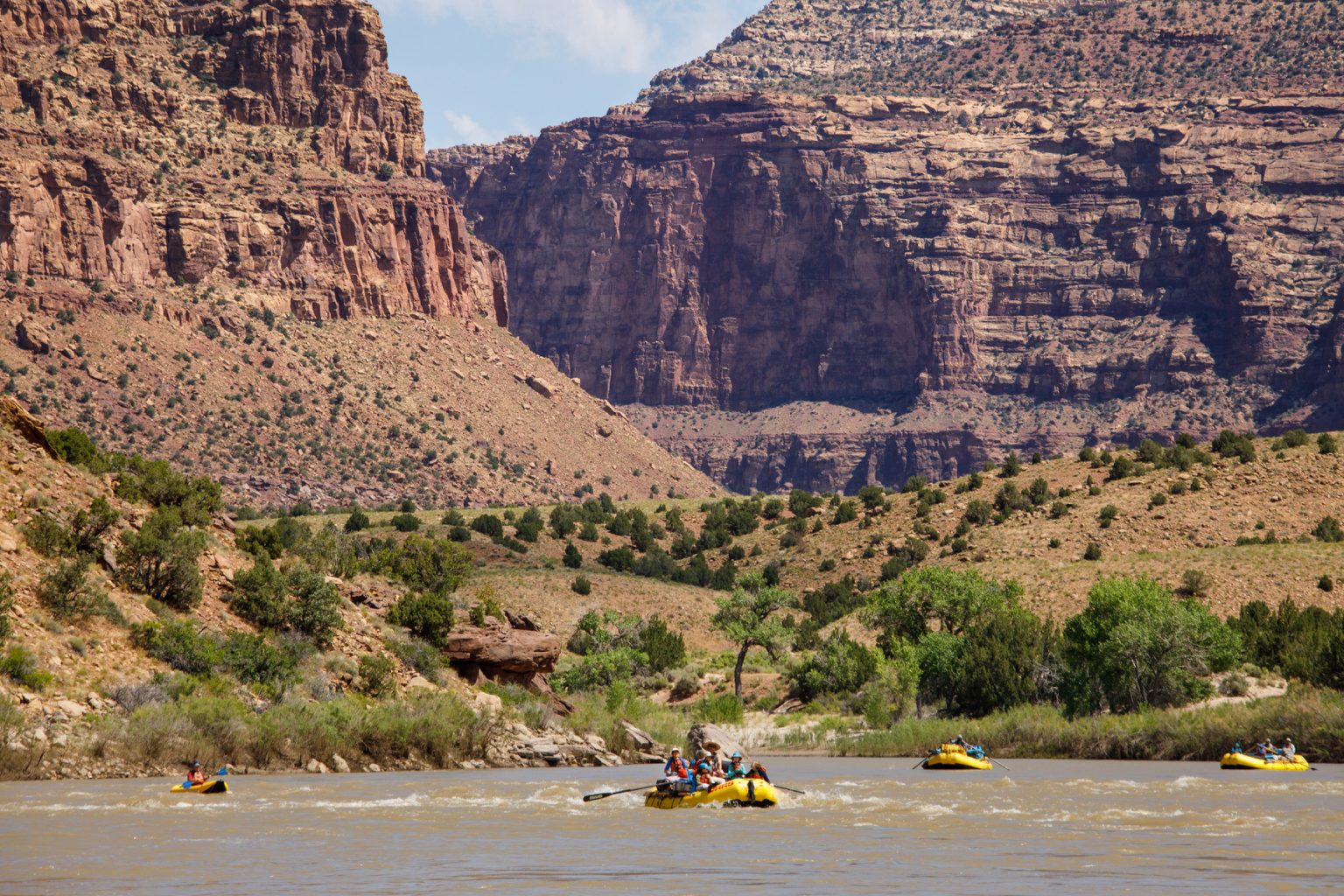
Healthy River Season Ahead for Utah
The Upper Green River Basin is currently at 103% of the April 1 average. For popular Green River rafting trips like the Gates of Lodore in Dinosaur National Monument and Desolation Canyon further downstream, a normal season is welcome news.
A snowpack above 100% combined with good soil moisture means all that snowmelt will be flowing into the rivers, positioning outfitters for a healthy rafting season this year, according to Lavoie.
Beyond a strong snowpack, outfitters that operate on the Green River through Flaming Gorge, Gates of Lodore and Split Mountain are also at the mercy of upstream dam releases from Flaming Gorge Reservoir. Now, with two above average water years in a row, Flaming Gorge Reservoir is sitting at 83% its capacity and outfitters are hopeful this will improve the prospects for daily water releases that will only improve conditions on the Green River this season.
But for a river that can be run at a wide range of flows, the normal snowpack in this region means paddlers can count on raftable water levels all season long into early September, along with the spectacular beauty, unbeatable camp spots and fun whitewater that these trips are known for. Typical higher flows are anticipated mid-May to mid-June.
Desolation Canyon will be particularly prime this spring and early summer, according to John Covington, OARS Moab Operations Manager. “It’s gorgeous down there when there’s a lot of water,” says Covington. “Everything is super green.”
The Upper Colorado River Basin snowpack, which feeds the Colorado River above Lake Powell, is at 112% of average. That’s the second year in a row with above average conditions for Cataract Canyon rafting trips, which during peak flows can have some of the biggest whitewater in the western U.S.
In 2023, during one of the most memorable whitewater seasons of the last decade, the Colorado River peaked at 66,000 CFS in Cataract Canyon in late May. This season, the Colorado Basin River Forecast Center’s median peak flow projections for Cataract Canyon are estimated at 45,000 CFS. If cooler weather patterns continue and peak flows are consistent with current projections, river runners looking for big thrills will not be disappointed, according to Covington.
We won’t see peak water conditions as high as 2023, but Covington attests that even flows in the 40,000 CFS range, which he experienced last season, can produce incredibly large and lively whitewater conditions.
For paddlers who want an elevated level of excitement, Covington says he anticipates water levels to start rising at the beginning of May with the peak at the end of May, similar to last season. For those looking for more normal conditions, water levels should begin to taper toward the end of June, providing fun and consistent flows into early October.
For a shorter Colorado River rafting adventure, Westwater Canyon on the Colorado-Utah is a perfect combo of scenic floating and exhilarating Class IV whitewater. This is a trip that’s ideal late April to early May, or after peak flows typically beginning in early July since the canyon’s best rapids typically flush out at higher water levels.
The San Juan River, a tributary of the Colorado River, also has a snowpack that’s slightly above average which will boost spring flows on this extremely scenic river trip and eventually flow into drought-stricken Lake Powell.
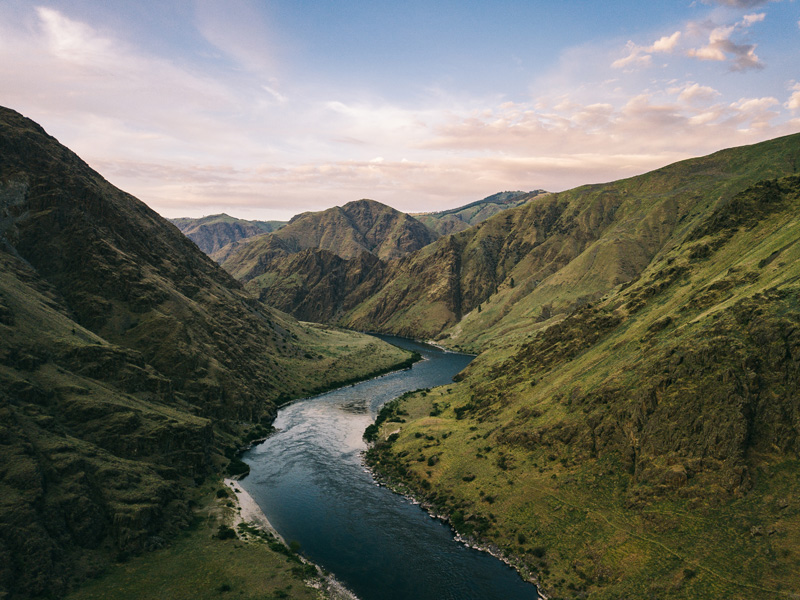
Business as Usual on Idaho’s Rivers
The snowpack in Idaho’s northern panhandle is slightly below normal, but the rest of the major river basins are sitting near or above the April 1 average.
“There is slightly less snow in the watersheds for our rivers than there was in 2023, but overall still looking strong,” says Lauren McCullough, OARS Idaho Operations Manager. “A few of the rivers we run, the Snake and Owyhee, are looking just as strong as they were last year.”
SNOTEL data the second week of April shows the Snake River Basin at 101% of normal, which promises rafters good conditions through the summer. But according to McCollough, June is the best time to be in Hells Canyon after a wetter winter when everything is lush and green. “It’s like the Shire from Lord of the Rings out there, but with mountains,” she says.
In the Salmon River drainage, the snowpack is 92% of normal, but the weather pattern over the next few weeks will really determine what plays out on the Salmon River.
“If it gets really warm all at once, the snow could melt quickly, or if we have a long cool spring the mountains can hold the snow longer and we’ll get a longer, gentler melt throughout the summer,” says McCollough.
A cooler spring that provides a gentler snowmelt is always ideal on the Salmon River for healthy, sustained flows into late summer, but this season outfitters are are simultaneously hoping for a high-water spring melt that is dramatic enough to clear a debris flow that is currently blocking the upper 25 miles of the Middle Fork Salmon and could impact where trips begin.
On the Idaho-Oregon border, the Owyhee Basin is more than 200% of normal for the second year in a row, which will provide optimal flows for Owyhee River trips, arguably the best spring river trip in the West. OARS currently has one departure available on May 2 with limited availability.
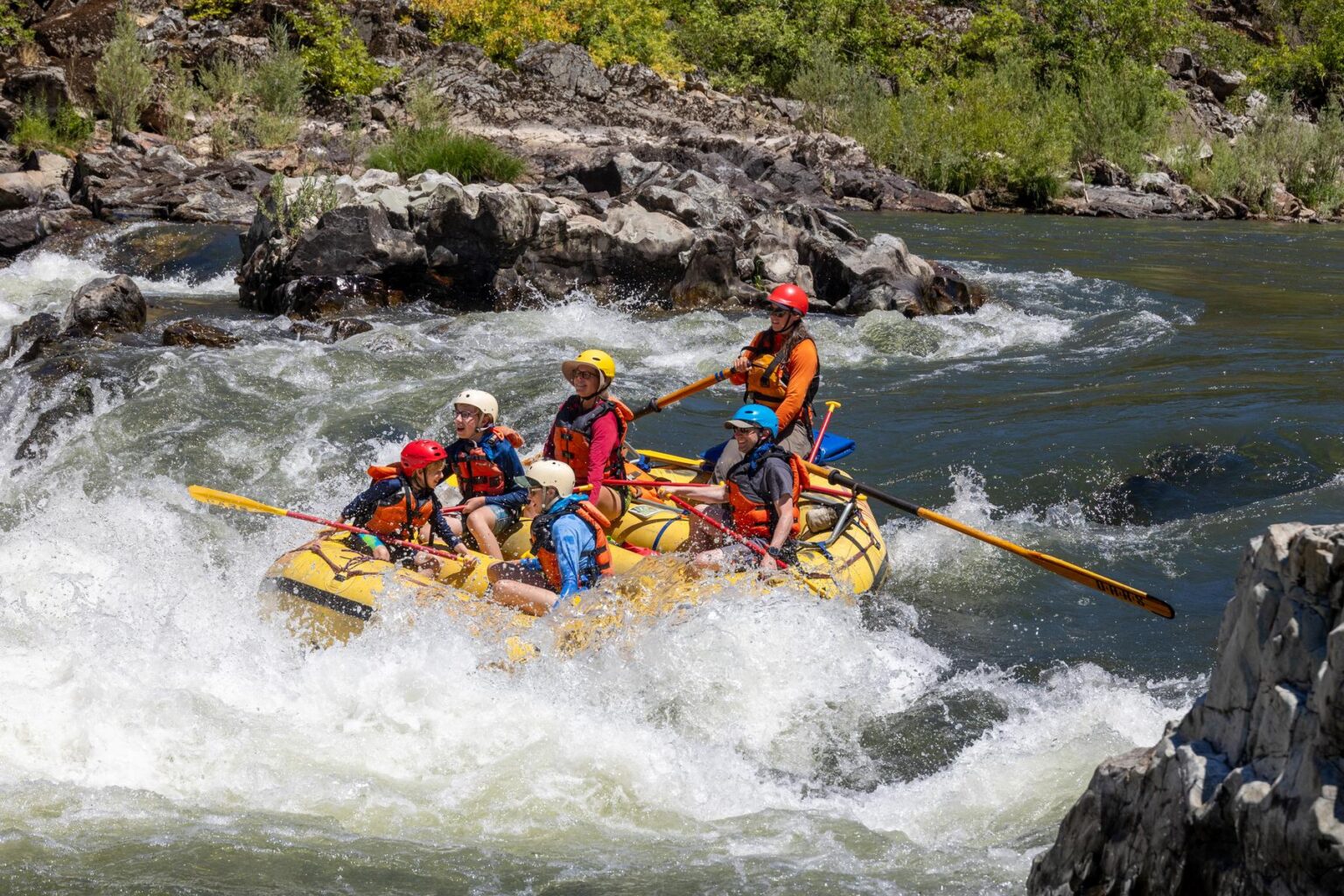
Oregon Rafting at its Best
In Oregon, NRCS Snotel data shows all of the major river basins are near normal to above average.
After last year’s unusually massive winter snowpack that measured well above the 30 year average across the state, the current snowpack for the Rogue drainage is at 121% of the April 1 average, which means outfitters won’t be expecting any big surprises.
”We are expecting a pretty ‘normal’ year for rafting on the Rogue River,” says Dustin Abbott, OARS Oregon Operations Manager. “This typically means we will see flows in the 3,000 to 5,000 CFS range in May and June, then slowly tapering throughout the rest of the summer.”
Regardless of water levels, Abbott adds that the Rogue is always a beautiful, exciting, and fun experience for all. The Rogue also provides one of the best settings for a variety of specialty rafting trips OARS offers that cater to people’s unique interests like Craft Beer Tasting, Wine Tasting, Wilderness Gourmet and All-Adult departures.
OARS is also watching developments on the Klamath River on the Oregon-California border where the largest dam removal project in the U.S. is expected to be completed by fall 2024.
“Due to the historic removal of dams on the Klamath and the uncertainty of flows and water quality, we will not be operating on the Lower Klamath this year,” according to Abbott. “We will be watching flows throughout the season to help determine appropriate operations for next year.” OARS is currently taking advanced reservations for 2025 for those interested in being among the first rafters to see a river reborn.
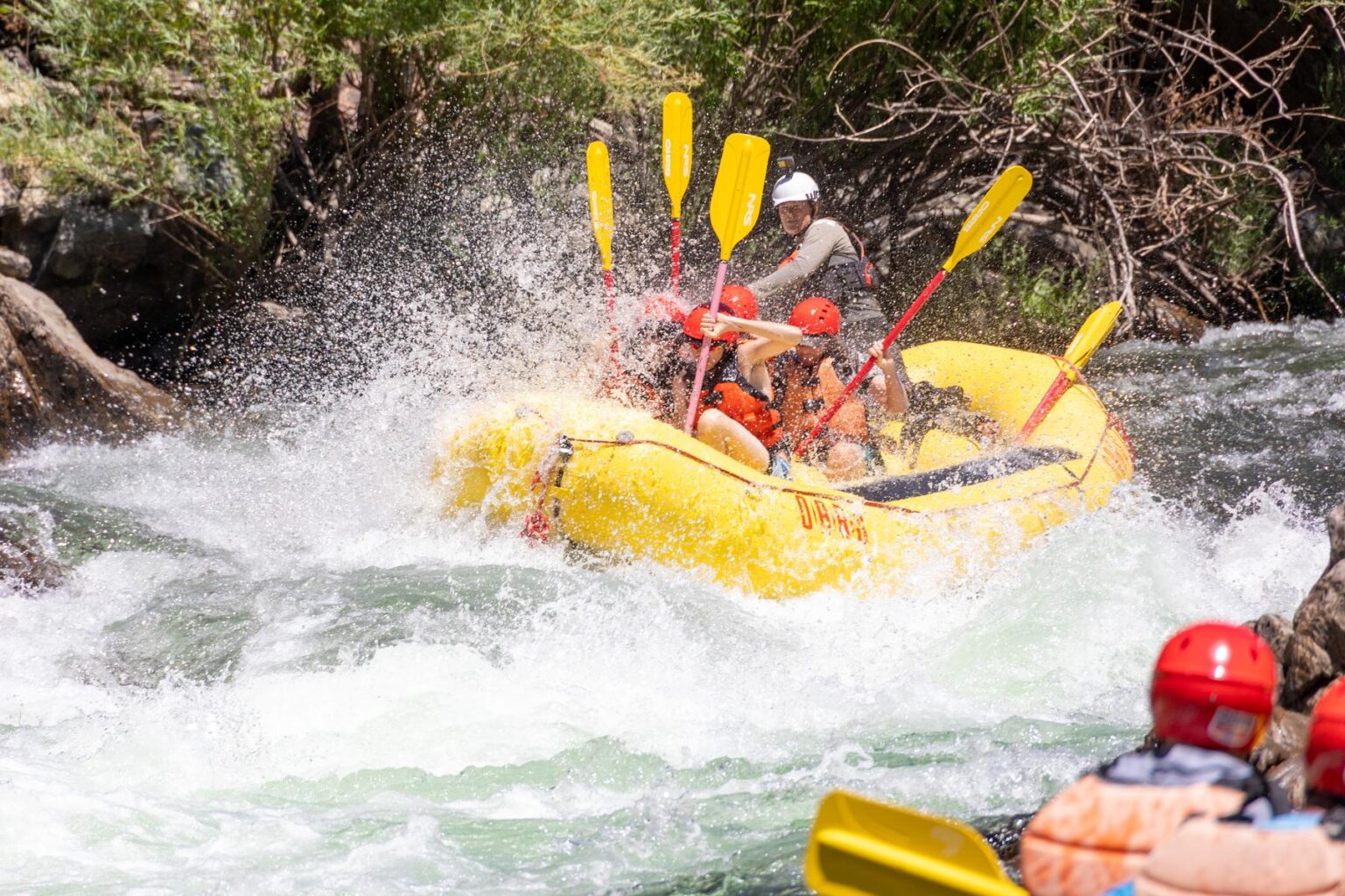
California Whitewater Outlook a Welcome Balance
Winter began slowly in California, but thanks to a series of atmospheric rivers in February and March, the statewide snowpack is above average for the second year in a row. The April 1 snowpack survey measured 110% of the average, according to the California Department of Water Resources.
“California is shaping up to have a solid rafting season with statewide snowpack numbers above average and reservoirs still full from the 2023 winter,” says Jess Wallstrom, OARS California Operations Manager. “We are excited for normal conditions compared to the spring of 2023 when we had to cancel many trips due to high-water conditions.”
Following another storm the first week of April, the American River Basin now sits at 119% of normal. That bodes well for the popular South Fork and Middle Fork of the American River where outfitters are looking forward to operating trips seven days per week, opposed to drier years when operations can be more limited due to fewer daily recreational water releases from upstream reservoirs.
Wallstrom still expects a high-water window on the American River in April to early-June, but more moderate, family-friendly flows will return before the busy summer months.
Last season, outfitters also had to navigate a road closure that made accessing the put-in for Middle Fork of the American River rafting trips more difficult, but Wallstrom expects the road to Oxbow Reservoir to be reopened just in time for Memorial Day Weekend when trips on the Middle Fork will begin for the 2024 season.
Those looking for an exciting Class IV adventure before Memorial Day can count on the North Fork of the American River this spring for big thrills. This scenic and free-flowing stretch of river is expected to run through late-May to early-June this season.
Further south in the Central Sierra, snowpack measurements for the Tuolumne River and Merced River, are both sitting near 100% of normal.
On the Tuolumne, rafters can expect reliable flows from late April until Labor Day with peak flows anticipated late-May through early-June. After a delayed start to trips on the Tuolumne River last year due to excessive road damage that limited access to both the put-in and take-out, outfitters are looking forward to a normal season this year, albeit with some logistical changes that will be in place for the foreseeable future. This includes a scenic 1.5-mile hike to the put-in that only adds to what is considered Calfironia’s premier whitewater adventure.
On the free-flowing Merced River, on the other side of Yosemite National Park, outfitters are expecting to see reliable flows into mid-July, depending on how quickly the snow melts, with probable peak flows expected late-May through early June. Unlike 2023 where peak flows on the Merced were pushing operational limits at times, this year should offer a more consistent season with normal water levels that offer a fun and exciting wave-train ride, according to Wallstrom.
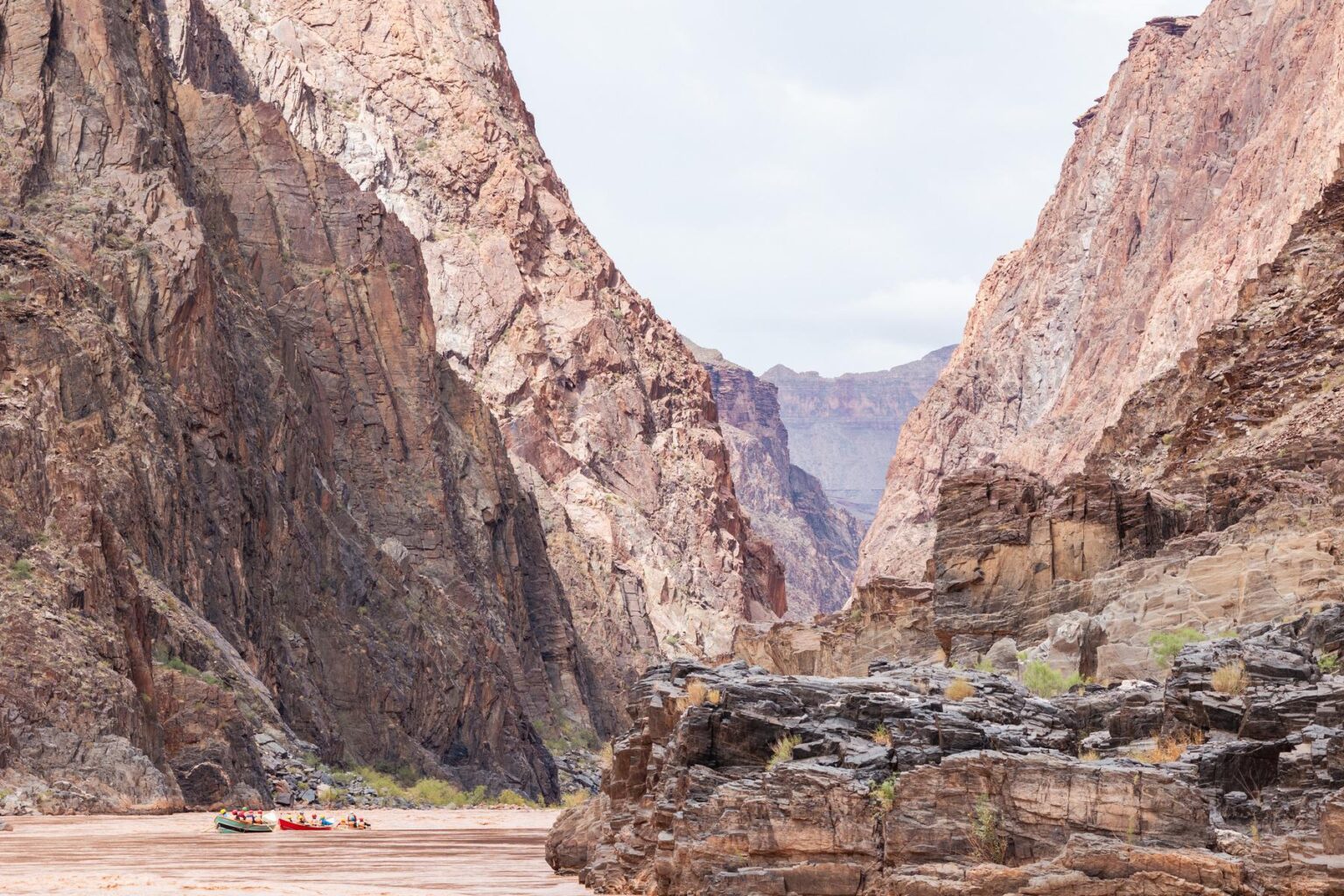
No Surprises in Grand Canyon
After two consecutive winters with an above average snowpack in the Colorado River Basin, Lake Powell Reservoir, which feeds the Colorado River through Grand Canyon, is expected to increase another 21 feet.
“Our flows in Grand Canyon are managed to the last drop by the Bureau of Reclamation and Glen Canyon Dam,” says Lars Haarr, OARS Grand Canyon Operations Manager. “That said, flows are determined by complex agreements between Upper and Lower Basin states, so some of that snow will head downstream through Grand Canyon.”
Notwithstanding any new agreements reached between Basin states this year, Haarr anticipates flows similar to the past year. Spring flows typically range between 8,000-13,000 CFS, ramping up in the summer to 10,000-15,000 CFS when dam operators release more water to manage increased power demands.
“The great thing about boating in Grand Canyon is that no matter what the water level, there are going to be fun rapids—some are better at higher flows, and others better at lower or more moderate flows,” says Haarr. “Of course, there’s always the fan-favorites of Hance, Hermit, Crystal, and Lava Falls, which offer excitement no matter the water level.”
For people hoping to snag a last-minute Grand Canyon rafting or dory trip, there is still limited space available for the 2024 season and 2025 trips are filling fast.
Related Posts
Sign up for Our Newsletter

